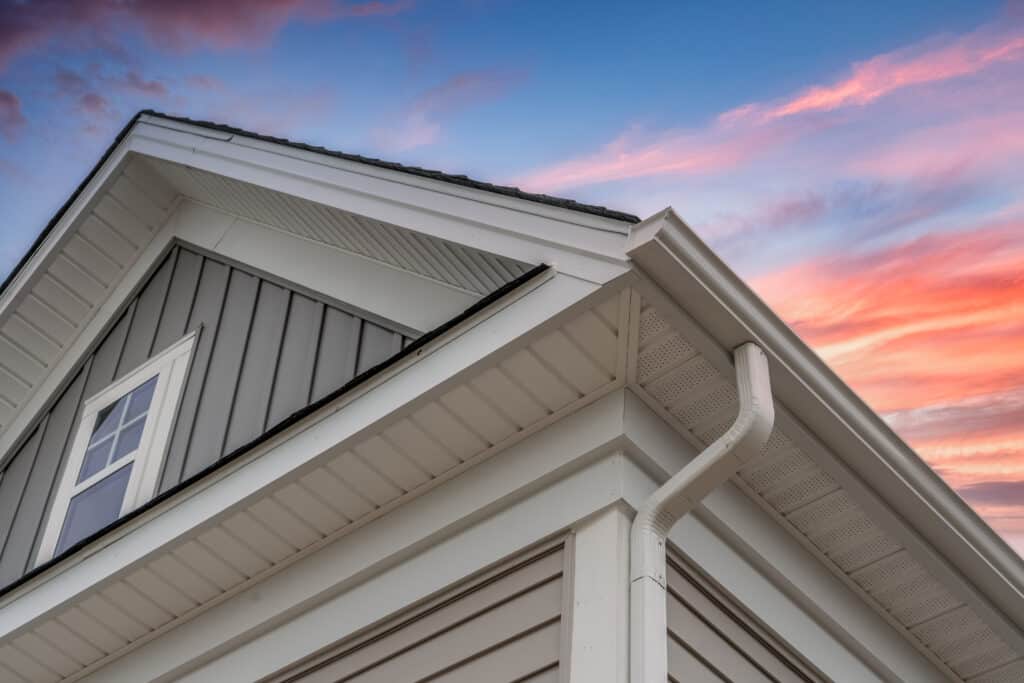Soffit and Fascia Replacement and Repair Services
Extend Your Roof's Lifespan with Proper Soffit Ventilation

TYPES OF SOFFIT FOR YOUR HOME
Metal Vents
One of the oldest ventilation options, these individual aluminum vents come in many sizes with a variety of air intake options. This more affordable option is installed direction into wood soffit and is usually painted with the wood for a cleaner look.
Vented Soffit
Vented soffit is widely used and provides a decent amount of intake for your attic space. Available in a variety of materials and colors, vented soffit will range in price but is usually one of the cheaper options for homeowners.
Hidden Vent
Hidden Vent soffit is a more aesthetically pleasing version of its vented cousin. The soffit looks like there is no holes for air flow as it is hidden on the panels. It usually overs more intake per linear foot as well.
SOFFIT INSTALLED CORRECTLY LETS YOUR ROOF BREATHE
Soffit and fascia repair and replacement are often forgotten in exterior remodels of Minnesota and Wisconsin homes. Unless you have a significant porch overhang, it is rare for anyone spend much time under their soffit. Meanwhile, half of your home’s fascia is covered by gutters. That being said, it is understandable that homeowners don’t really consider soffit and fascia while planning their home’s exterior renovation.


The experts at Nordic Exteriors are here to tell you that your soffit and fascia are incredibly important and that there is a very good chance your roof is not being ventilated properly. Throwing some old school turtle vents (box vents) up on the roof or upgrading to ridge vent on the peaks is solving a problem with only half of the solution. The other half is solved with properly vented soffit.
While your soffit is bringing air into your roof, the fascia has it’s own important function. Fascia protects your roof rafters and trusses from the all the nasty weather the Midwest brings. On the eaves (the lower edges of the roof) it provides a solid surface for your gutters to attach to. Add some well fabricated trim metal for additional protection for your home and support to keep your soffit fastened securely. Think of fascia as that finishing touch to the exterior of your home.
FAQ About Soffit and Fascia Remodeling Services
What is soffit?
Soffit is on the underside of the roof overhang. It protects your rafters while providing ventilation for your roofs attic space. While often ignored, soffit offers additional aesthetic potential with options ranging from wood, vinyl, aluminum and steel,
What is fascia?
Fascia is the horizontal transition board between your roof and homes exterior wall. While covering the exposed ends of rafters and trusses, fascia is what your gutters are attached to. Although some homes have painted fascia, it is highly recommended to wrap the fascia with aluminum or steel. This is especially important when installing aluminum or vinyl soffit.
Can I install new soffit and fascia without replacing the siding?
Yes, you absolutely can install soffit and fascia without replacing your siding. If you are replacing your siding, it is important to install the new soffit and fascia before the siding but after the roof.
Are the intake vent options besides soffit?
You are in luck! As of the mid 2000s, a new affordable intake option has been made available in the form of a shingled-over, rooftop installed intake vent. Read more about roof ventilation or talk to your Exterior Renovation Expert today to find out if this solution is right for you.
What is ventilation so important?
Proper ventilation increases the lifespan of your roof. With the correct intake and exhaust, the temperature and moisture levels stay regulated which prevents mold, ice dams, and overall failure of your roof system.
What is NFVA (NVA)?
NFVA or Net Free Ventilation Area is the total unobstructed area of attic space that allows air to flow and vent. While construction operates in square feet and linear feet, NFVA is measure in square inches. The volume of your attic is not taken into account, but rather the length and width of the attic space.
Every state and county has ventilation requirements ranging from the rule of 1:150 and 1:300.
MN STATE CODE
WI STATE CODE
The basic NFVA formula is:
Attic Square Footage / 150 or 300 * 144.
Then divide that by 2 and VOILA! You now know the required intake and exhaust to properly ventilate your roof.
How do I figure out my current NFVA?
This is a bit time consuming. However, if you choose the right contractor, they will be able to assist you with this.
But we are not here to gatekeep.
Step 1: Find out what your current soffit is and look up the square inches of ventilation it provides.
Step 2: Measure the length and depth of your soffit at the eaves.
Step 3: Do some math!
If you have 100 feet of soffit that is 12 inches deep, you have 100 sq feet of soffit. If your soffit offers 5.89 sq inches per sq foot of air flow/ventilation then your have a total intake of 589 sq inches of intake. That is a lot of intake! For reference, the best ridge vent offers around 13.5 sq in per LF (linear foot). That means you would have to have 44 LF of ridge vent to have a perfect air flow.
There are a lot of factors that go into NFVA. Make sure your contractor or roofer is taking care of you and your home the right way.
I have wood soffit and no vents! What do I do?!
It is ok! There is a solution for wood soffit with an array of metal vents that be installed right into the wood. If you want to make the upgrade to vinyl or even steel soffit, an evenly distributed and math backed holes will be cut into the soffit around the home. Then, the new soffit can be installed over the wood, ensuring the correct air flow is occurring around the home.
